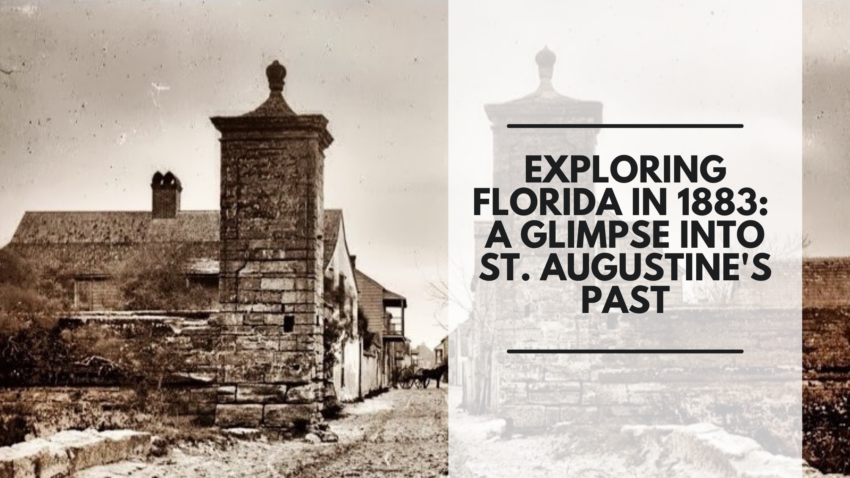Exploring Florida in 1883: A Glimpse into St. Augustine’s Past

Watching period pieces on TV always gets me wondering, “what was happening in my city during that year?” Recently, after binging all of Yellowstone, I moved on to its origin story, the TV show 1883. A few minutes in I started Googling “map of the USA in 1883”. The Dakota Territory stands out as it has not been split into North and South, and Oklahoma is still referred to as Indian Territory, but the lower 48 have most of their current borders. We still had a bunch of “US Territories” though, as only 38 have been admitted as states into the Union. While the West was still wild, the Brooklyn Bridge is finally completed after 10 years of construction. 1883 was also significant because it was one of the first times that detailed descriptions of a colossal news event traveled around the world quickly, carried by undersea telegraph wires. Readers of daily newspapers in Europe and North America were able to follow current reports of the disaster and its enormous implications.
As we delve into the events that unfolded in St. Augustine and other parts of Florida in the year 1883, we find ourselves transported to a time of transformation, growth, and innovation. Let’s take a journey back in time and explore the significant happenings that shaped the region during this remarkable period, the same year the fictional Dutton family set out for the Montana Territory.
St. Augustine – A Winter Resort for the Elite:
- 1883 marked the beginning of St. Augustine’s transformation into a sought-after winter resort for the wealthy northern elite. The city’s pleasant climate and charming ambiance attracted visitors seeking respite from the harsh winters up north.
Preserving the Past: The St. Augustine Historical Society
- In the same year that St. Augustine was undergoing a transformation into a winter resort for the elite and witnessing significant developments in various sectors, another important institution was taking root. Founded in 1883, the St. Augustine Historical Society emerged as a gathering of like-minded individuals passionate about natural history and preserving the region’s rich heritage. Over the years, the society’s mission evolved to encompass not only natural history but also the broader historical significance of St. Augustine. Their primary goal became the preservation, study, and promotion of the city’s historical, architectural, and cultural heritage. This year the Historical Society turns 140!
Governor William D. Bloxham’s Tenure:
- William D. Bloxham assumed office as the Governor of Florida in 1883, the first of his two non-consecutive terms. During his administration, he reestablished the State Railroad Commission and aided the federal government in the Spanish-American War.
Establishment of the Bank of St. Augustine:
- On March 1, 1883, the Bank of St. Augustine was established by Messrs. G.W. Gibbs and John T. Dismukes. With a capital of $10,000, the bank quickly gained popularity and conducted a thriving exchange business. Its well-appointed quarters on St. George Street, near the Plaza, made it a notable institution in the city.
St. Augustine’s Population and Surrounding Towns:
- In 1883, the population of St. Augustine was approximately 5,000 residents. The county was home to only a few other towns, including Carterville, Fruit Cove, Switzerland, Matanzas, Moultrie, Orangedale, Picolata, Racy Point, and Remington Park. The entire state of Florida had a population of just under 300,000 residents. (2023 estimate is 22.25 million!)

Villa Zorayda – A Marvel of Moorish Revival Architecture:
- The year 1883 witnessed the construction of the Villa Zorayda, a stunning winter home built by Franklin Webster Smith. Using his innovative method of construction, which involved poured concrete and crushed coquina shell, Smith designed the villa in the Moorish Revival style, inspired by the Alhambra Palace in Granada, Spain. The Villa Zorayda set an architectural precedent during the Gilded Age and played a significant role in shaping the city’s Moorish Spanish Revival architectural style that continues to charm visitors to St. Augustine today.
Henry Flagler and Florida’s Tourism Potential:
- In 1883, Henry Flagler married Ida Alice Shourds. The couple’s visit to St. Augustine left them enchanted by the city’s allure, but they noticed a lack of adequate hotel facilities and transportation systems. Flagler saw the untapped potential of Florida as a tourist destination and set out to transform it.
The South Florida Railroad and Tampa’s Transformation:
- Henry B. Plant’s South Florida Railroad became the first railway to reach Tampa, marking a turning point in the city’s history. Alongside the railroad’s expansion, luxury hotels sprouted, heralding a new era of travel and tourism in Florida.
Tampa – A Thriving Shipping Metropolis:
- Thanks to Henry Plant’s efforts, Tampa grew into a major deep-water port that facilitated trade with Cuba and other Caribbean islands. The establishment of shipping facilities further boosted the city’s economic growth.
Railroad Expansion to Pensacola:
- William D. Chipley’s railroad extended to Pensacola and seamlessly merged with Henry Plant’s railways, connecting the panhandle to the rest of the state. This railroad expansion enhanced transportation and trade opportunities for the region.
Combatting Smallpox in Jacksonville:
- In response to the 1883 smallpox epidemic, an isolation pavilion was constructed at Duval Hospital and Asylum in Jacksonville. This facility played a crucial role in containing and managing the outbreak.
As we reflect on these events from the past, we gain a deeper appreciation for the rich history and development that has shaped St. Augustine and Florida into the vibrant and diverse region it is today. Join our St. Augustine Historic Tour as we continue to journey through time, exploring the stories of our ancestors and the legacy they left behind.